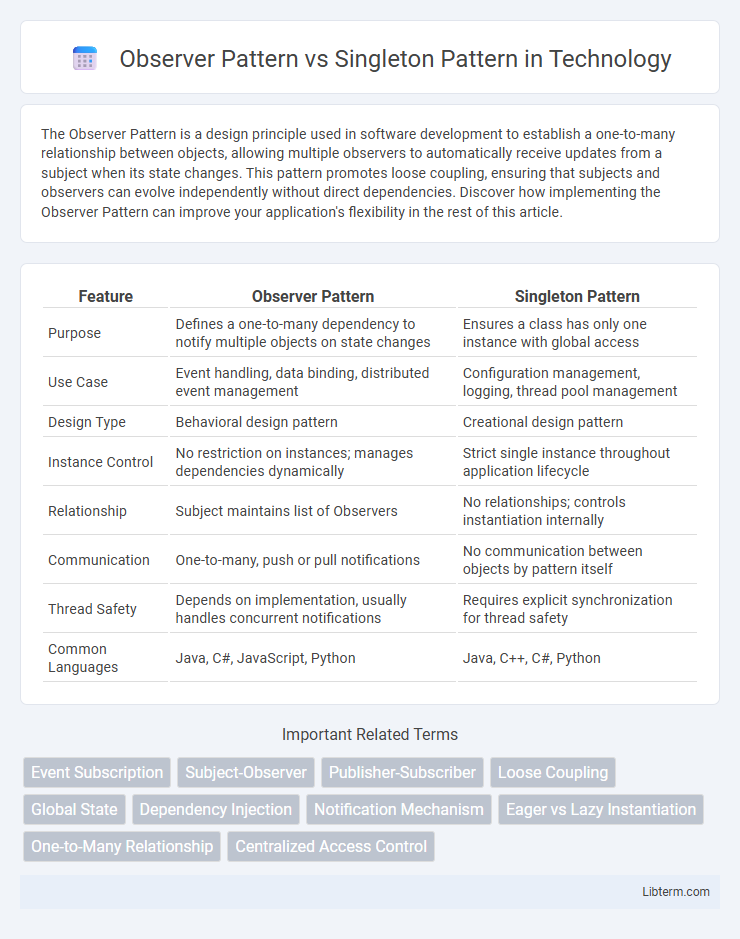The Observer Pattern is a design principle used in software development to establish a one-to-many relationship between objects, allowing multiple observers to automatically receive updates from a subject when its state changes. This pattern promotes loose coupling, ensuring that subjects and observers can evolve independently without direct dependencies. Discover how implementing the Observer Pattern can improve your application's flexibility in the rest of this article.
Table of Comparison
| Feature | Observer Pattern | Singleton Pattern |
|---|---|---|
| Purpose | Defines a one-to-many dependency to notify multiple objects on state changes | Ensures a class has only one instance with global access |
| Use Case | Event handling, data binding, distributed event management | Configuration management, logging, thread pool management |
| Design Type | Behavioral design pattern | Creational design pattern |
| Instance Control | No restriction on instances; manages dependencies dynamically | Strict single instance throughout application lifecycle |
| Relationship | Subject maintains list of Observers | No relationships; controls instantiation internally |
| Communication | One-to-many, push or pull notifications | No communication between objects by pattern itself |
| Thread Safety | Depends on implementation, usually handles concurrent notifications | Requires explicit synchronization for thread safety |
| Common Languages | Java, C#, JavaScript, Python | Java, C++, C#, Python |
Introduction to Design Patterns
The Observer Pattern enables objects to automatically notify and update dependent components when their state changes, promoting loose coupling in software design. The Singleton Pattern ensures a class has only one instance and provides a global point of access to that instance, controlling resource usage and maintaining consistent state. Both patterns address specific design problems: Observer focuses on communication between objects, while Singleton emphasizes controlled instantiation.
Understanding the Observer Pattern
The Observer Pattern enables a one-to-many dependency between objects, allowing multiple observers to automatically receive updates when the subject's state changes. This design promotes loose coupling, as observers and subjects interact through well-defined interfaces without direct knowledge of each other's implementations. Understanding the Observer Pattern is essential for implementing event-driven systems where dynamic subscription and notification mechanisms improve modularity and scalability.
Understanding the Singleton Pattern
The Singleton Pattern ensures a class has only one instance while providing a global access point to that instance, commonly used in logging, configuration settings, or connection pooling. It restricts instantiation by making the constructor private and controlling instance creation through a static method, preventing multiple objects that could cause resource conflicts. Understanding the Singleton Pattern is crucial for managing shared resources efficiently and maintaining consistent application state without synchronization issues.
Key Differences Between Observer and Singleton Patterns
The Observer pattern establishes a one-to-many dependency between objects, allowing multiple observers to receive updates automatically when the subject's state changes, whereas the Singleton pattern restricts a class to a single, globally accessible instance. Observer facilitates dynamic communication and loose coupling between objects, while Singleton controls instance creation to ensure resource management and consistent access. Key differences include their purpose--Observer for event-driven state change notifications and Singleton for instance control--and their structural impact on system scalability and object relationships.
Use Cases for Observer Pattern
Observer Pattern is essential for implementing event-driven systems where multiple objects need to stay updated with state changes, such as in GUI frameworks for handling user interface events or in real-time data visualization tools. It is widely used in distributed event handling, modular applications, and asynchronous programming to facilitate loose coupling and maintainability. Unlike Singleton Pattern, which restricts a class to a single instance for shared resource control, Observer Pattern excels in scenarios requiring dynamic subscription and notification mechanisms among multiple dependent objects.
Use Cases for Singleton Pattern
The Singleton Pattern is ideal for managing shared resources such as database connections, configuration settings, or logging mechanisms where only one instance should exist throughout the application's lifecycle. This pattern ensures controlled access to a sole instance, preventing resource conflicts and promoting efficient memory usage. It is commonly used in scenarios requiring consistent state management and centralized control.
Pros and Cons of Observer Pattern
The Observer Pattern enables dynamic one-to-many dependency management, allowing multiple objects to be notified and updated automatically when the subject changes, which promotes loose coupling and scalability in complex systems. However, it can introduce performance overhead due to frequent notifications and potential memory leaks if observers are not properly deregistered, complicating resource management. This pattern is ideal for event-driven designs but may cause issues in scenarios requiring strict control over update order or when dealing with a high volume of observers leading to latency.
Pros and Cons of Singleton Pattern
The Singleton Pattern ensures a single instance of a class, providing controlled access to shared resources and reducing memory consumption. However, its drawbacks include making unit testing difficult due to global state, introducing hidden dependencies, and potential issues with multithreading if not implemented correctly. Overuse of Singleton can lead to tight coupling and reduced code flexibility, impacting maintainability in large projects.
When to Choose Observer vs Singleton
Choose the Observer Pattern when multiple objects need to be notified and updated automatically in response to changes in a subject, enabling a one-to-many dependency and promoting loose coupling between components. Opt for the Singleton Pattern when exactly one instance of a class is required to control a centralized resource or configuration, ensuring global access without the overhead of multiple instantiations. The Observer Pattern excels in scenarios demanding dynamic communication and event-driven architectures, while the Singleton Pattern is ideal for managing shared state or coordinating actions through a single access point.
Conclusion: Selecting the Right Pattern
Choosing between the Observer Pattern and Singleton Pattern depends on the specific design requirements and application context. The Observer Pattern is ideal for scenarios requiring dynamic, event-driven communication between objects with loose coupling, enhancing scalability and flexibility. The Singleton Pattern suits cases needing a single, globally accessible instance to coordinate resources or manage state, ensuring controlled access and consistency across the application.
Observer Pattern Infographic

 libterm.com
libterm.com